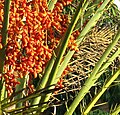| Phoenix sylvestris | |
|---|---|
 | |
| In West Bengal, India | |
| Scientific classification | |
| Kingdom: | Plantae |
| Clade: | Tracheophytes |
| Clade: | Angiosperms |
| Clade: | Monocots |
| Clade: | Commelinids |
| Order: | Arecales |
| Family: | Arecaceae |
| Genus: | Phoenix |
| Species: | P. sylvestris |
| Binomial name | |
| Phoenix sylvestris | |
| Synonyms [1] | |
| |
Phoenix sylvestris (sylvestris - Latin, of the forest) also known as silver date palm, Indian date, sugar date palm or wild date palm, [2] is a species of flowering plant in the palm family native to southern Pakistan, most of India, Nepal, Bhutan, Myanmar and Bangladesh. It has been introduced to southeastern China, Sri Lanka, Mauritius, Puerto Rico and the Leeward Islands. [1] Growing in plains and scrubland up to 1300 m above sea level, the fruit from this palm species is used to make wine and jelly. The sap is tapped and drunk fresh or fermented into toddy. The fresh sap is boiled to make palm jaggery in West Bengal state of India and Bangladesh.
Contents











